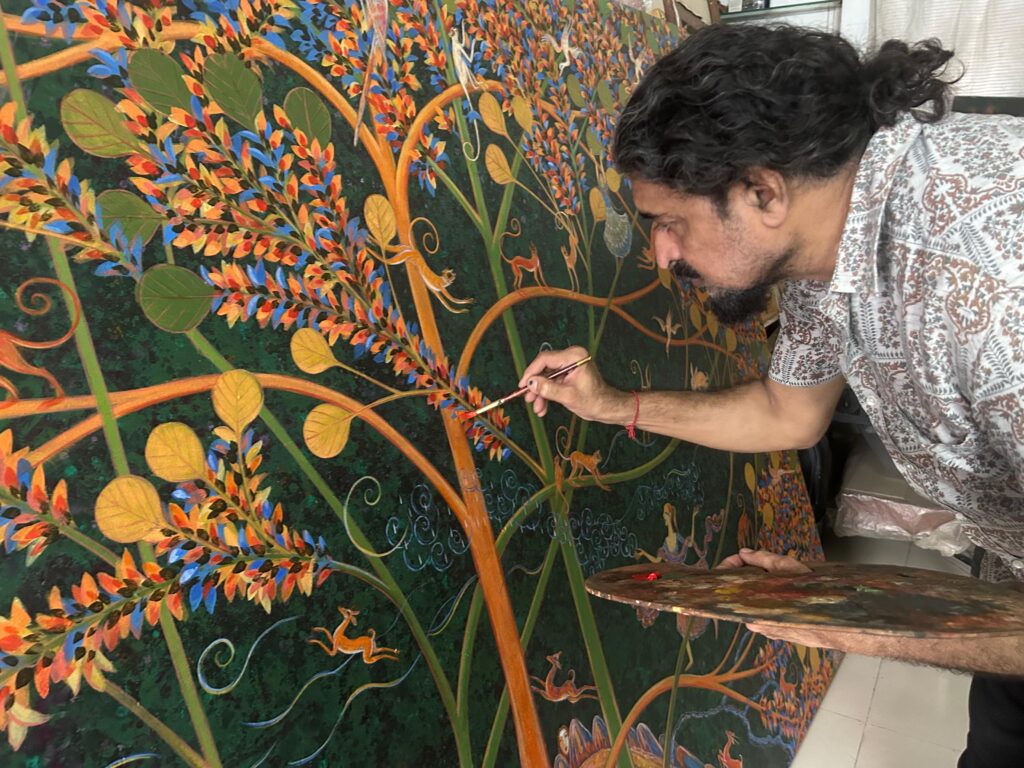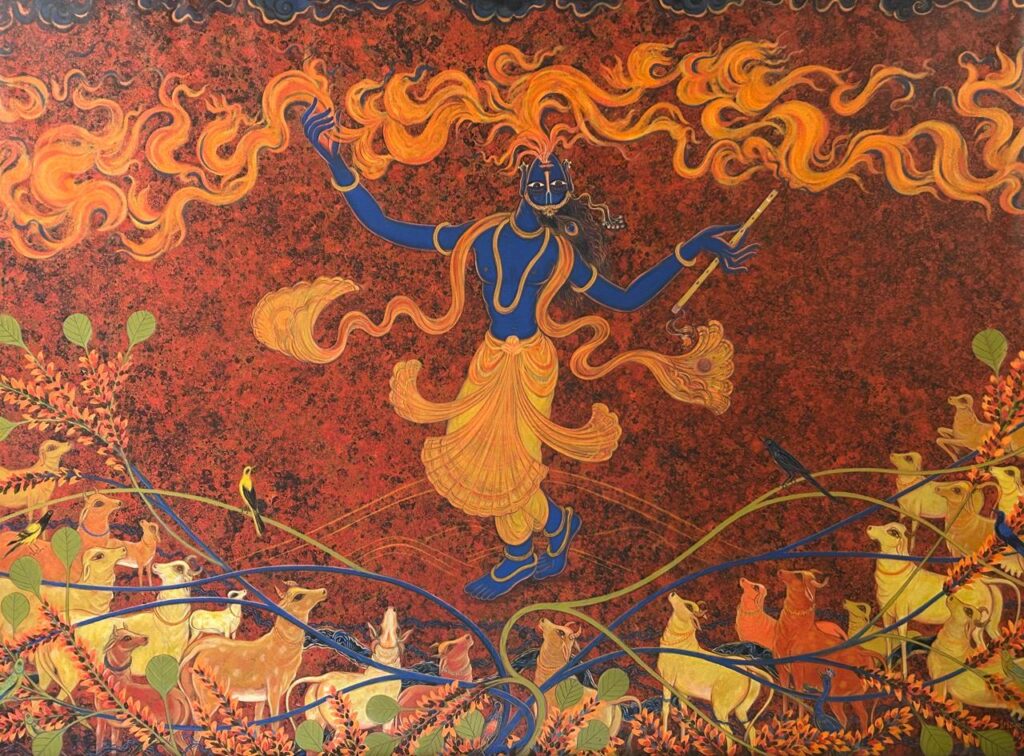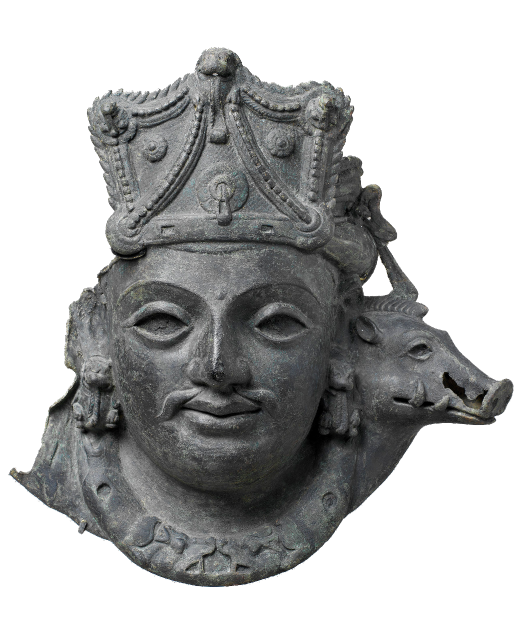PERSPECTIVES
The Last Court Painter
A sharp strand of light falls onto the canvas in Jitendra Baoni’s rooftop studio. Strewn across the canvas on the floor is a mosaic of colours depicting a musk deer searching for its fragrance in a forest of palash trees. The space tells its own story — cups of dried paint, unwiped spills, mugs holding brushes and charcoal, trays heaped with colour tubes. It is an active art studio in motion; the air brimming with ideas, waiting to be caught upon the surface of a blank canvas.
Baoni is the inheritor of a 36-generation lineage of court painters from Rewa, Madhya Pradesh. It is a legacy that weighs heavy on his shoulders. In a world increasingly dominated by digital disruption, he increasingly finds himself at a crossroad between preserving ancient techniques and adapting to contemporary realities.
Baoni hails from Rewa, nestled in the northeastern part of Madhya Pradesh and known for housing the last of the rare white lions. His earliest memory involves accompanying his father, Awadh Sharan Singh Baoni, to the Royal palace of Rewa, where he served as the court painter. In those palace halls, elaborate portraitures would be painted in an attempt to capture the essence of the maharaja’s power, status, and wealth. Each mannerism of the royal figure would be carefully studied — the tilt of a head, the weight of a gesture, the particular way the light caught his jeweled turban.
The final painting would reflect the maharaja’s quirks of personality and his favoured items of adornment and luxury. The painter’s observations would be transformed into luminous oil portraits that spoke not just of appearance but of authority itself. This was portraiture, as both art and documentation, where every brushstroke carried the weight of dynastic representation and every color choice reflected the careful balance between reverence and truth.
“There was no other direction to look towards,” Baoni reflects. “Growing up around art, it became the only thing you were naturally drawn to and became good at — to hold a brush, to mix paints, to draw bold strokes…”

Baoni and his father used to create brushes from stray squirrel hair and pigments from natural materials, arming themselves with a palette of sienna, ochre, and indigo. This ritual connected them to both their craft and the natural world in ways that modern art supply stores do not. “Like any other practice, art requires riyaaz — a meditation on the painting and religious exercise of the muscle,” Baoni explains, his hand moving in a gesture that is more habit than conscious thought. “Your hand tends to forget techniques if not practiced regularly.”
The Weight of Ancestry
The Baoni family has guarded secret techniques for 36 generations, particularly their “ivory painting” method. The key to the unmatched luminosity of the portraits created by them in the past was thanks to the ivory derived from tusks and large teeth of elephants, walruses, and whales, which was used to create a naturally translucent pigment. The technique to create and use this pigment was so highly coveted that Nandalal Bose once, in a letter to Baoni’s father, insisted that the master painter teach it to him. Another such secret technique was the Khakha drawing style, which acted as a stenciled outline for miniature paintings.
But modern times has brought in its own concerns. For instance, there are ethical implications of using the ivory painting method in this day and age, illustrating the tension between adaptation versus preservation of the family’s artistic legacy.

The family has faced this question before too, when Baoni’s father decided to work with Devare & Co., a photography studio in Bombay active in the early 20th century. The studio was known for their portraits of Indian royalty and referred to as “Photographers to the Government of Patiala.” Documenting royalty through different mediums — both painting and photography — positioned the family at the intersection of traditional techniques and emerging technologies of the modern world. Trying to balance these two paradigms is a dilemma that persists.
The Digital Dilemma
When asked about art going viral on Instagram in minutes compared to the years spent perfecting a single traditional technique, Baoni’s response illuminates the core tension within his practice. He believes that the immediate gratification of digital platforms challenges everything his family’s tradition represents — patience, precision, and the patient accumulation of skill over decades. But this does not mean that the way he has navigated through a period of change is rooted in technophobia. Rather, it concerns the nature of art itself as Baoni has found that the meditative, ritualistic aspect of traditional painting cannot be replicated in digital formats.

The resistance comes at a cost. While digital artists build global followings overnight, traditional artists like Baoni must navigate economic viability differently. However, he argues that the loss of royal patronage has changed the art market in ways that aren’t necessarily detrimental. “It has leveled the playing field and created alternate avenues to reach art buyers,” he insists. “It is only the names that have changed — the roles (of patronage) remain the same.”
Art gallery owners now play the role of maharajas. Gallery workers act as intermediaries who decide which art is worth redeeming and hanging on gallery walls. Art connoisseurs are making a concerted effort to understand different forms and mediums of art and recognise the hours that go into creating each piece. This growing awareness is blurring the miasmic gap that once existed between creating for a maharaja who understood the craft and selling to collectors who previously saw the work as mere decoration. Today’s collectors are increasingly educating themselves on artistic practices, bridging the chasm between patron and purchaser that once seemed insurmountable.
But while Baoni is hopeful of securing the patronage that traditional paintings deserve, the question of preserving the lineage is one that has no easy answers.
The Art of Observation
The transmission of knowledge in the Baoni family wasn’t through formal lessons but through what he calls “absorbed observation” — watching his father paint for hours, understanding the technique and the philosophy behind each stroke. He remembers how, as a young painter, he would look at the cows grazing on a green patch of land, and his hands would itch for a pencil and a sketchbook. The apprenticeship model, where artistic knowledge passes through years of watching rather than formal instruction, stands in stark contrast to modern art education. “What can you teach through words versus what can only be learned through years of watching?” he asks.
Back in the day, Baoni had moved away from home to pursue a formal arts education at the Maharaja Sayajirao Faculty of Fine Arts in Vadodara, Gujarat. There, he developed a distinct style of his own, but was heavily influenced by the lessons he had learnt from his father. Even now, there is a constant negotiation at play in his more contemporary work as he tries to find a balance between personal expression and the rigid conventions of his family’s traditional painting techniques.

As Baoni considers the future, he grapples with how to prepare the next generation for a world that may not value the traditional skills he wishes to impart. Some techniques especially resist verbalisation — they live between intuition and muscle memory. Baoni has come to believe that the solution to evading the erasure of Indian painting traditions like his family’s requires artists to go beyond mere techniques and immerse themselves in a certain way of seeing. One reason why Baoni continues to maintain the rituals of a court painter, despite the absence of the courts of patronage, is to retain the skills he was taught in a particular setting.
His studio routine, his preparation of materials, and his approach to each canvas, all carry the formality and reverence of someone still serving royalty because his daily riyaaz is what connects him to his ancestors. In Baoni’s quiet resistance to digital disruption and his determination to preserve his family’s legacy, we see not just one artist’s struggle, but the broader challenge of preserving cultural knowledge in an age of rapid change.
Aadya Baoni is a freelance multimedia journalist and an Erasmus Mundus scholar. Her work has been featured in BBC UK, Vice World News, and Quint. She also serves as a Communications Consultant at the United Nations.




